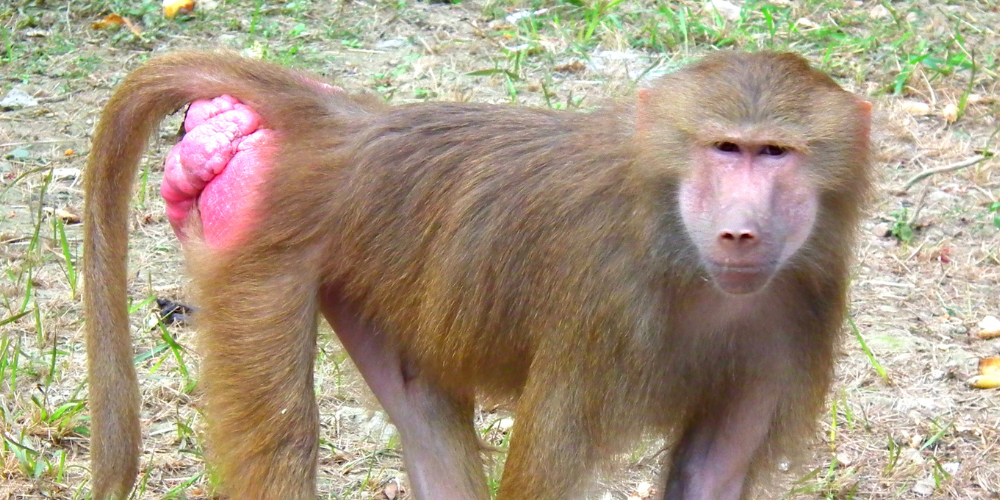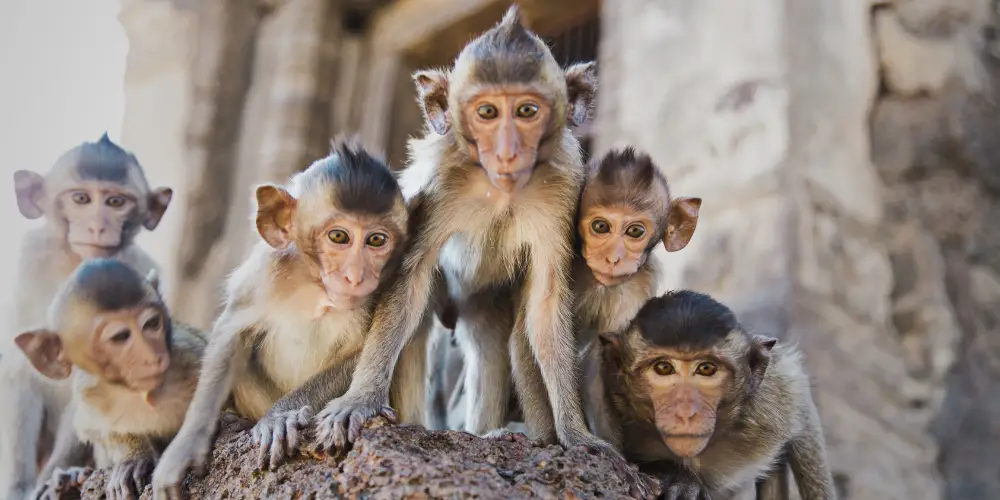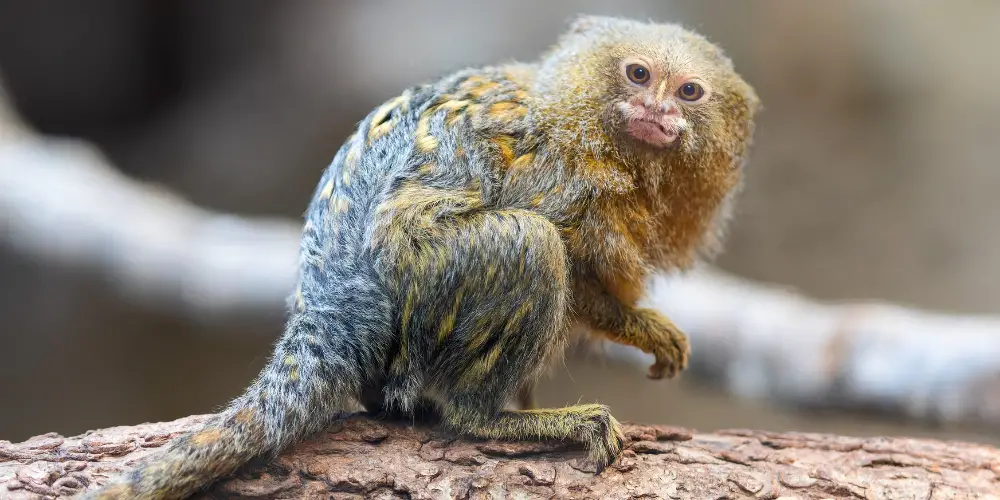Venture into the captivating universe of Red Butt Monkeys!
In this riveting journey, we meet seven distinct primate species celebrated not merely for their vibrant red behinds, but for the rich tapestry of traits and behaviors they bring to life.
We’ll be introducing you to the following species, each with its unique charm:
- Regal Hamadryas
- Guinea Baboons
- Japanese Macaques
- Rhesus Macaques
- Stump-tailed Macaques
- Celebes Crested Macaques
- Mandrills
Brace yourselves as we delve deeper to uncover the intriguing lives of these exceptional creatures.
Why is it Called “Red Butt Monkey?”
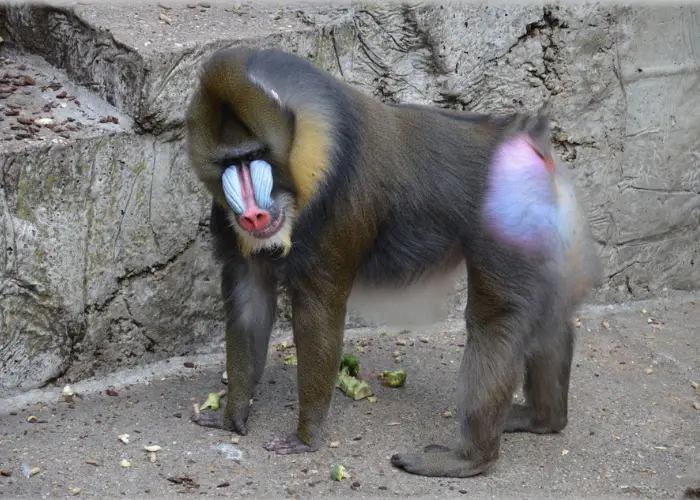
“Red butt monkey” is a colloquial way of referring to various primate species with red or reddish-pink buttocks. It is not a specific scientific classification or term but a common name used by people observing and interacting with these primates.
The term’s origin is unclear, but it may have arisen due to the eye-catching and distinctive coloration of these primates’ buttocks.
In some cultures, red is associated with attraction, aggression, or dominance, which may have contributed to using the term “red butt” to describe these primates.
The term “red butt monkey” is not used universally, and different regions or communities may have their names or descriptions for these primates.
For example, in Japan, the Japanese Macaque, a species with a red face and buttocks during the winter, is commonly called the “snow monkey” due to its ability to survive in cold climates.
While “red butt monkey” may not have a formal scientific basis, it is a useful and memorable way of referring to these primates in everyday conversation and communication.
Species of Red Butt Monkeys
1. Hamadryas Baboon
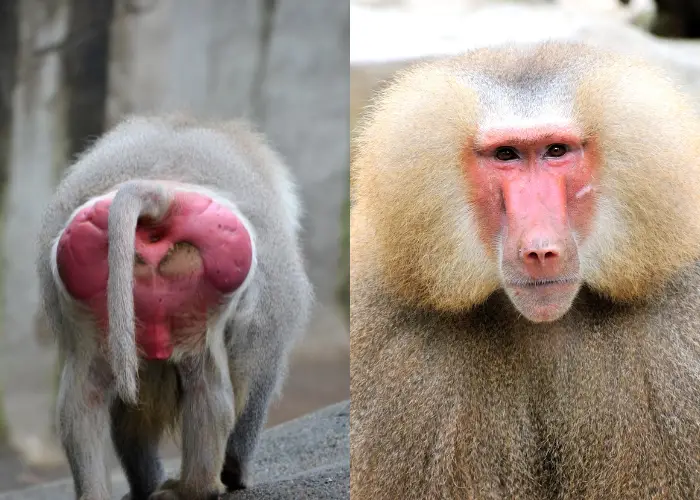
A. Description and Physical Characteristics
Hamadryas baboons (Papio hamadryas) are large, robust primates with distinctive reddish-pink patches on their buttocks. Males are significantly larger than females, with males weighing between 20-30 kg (44-66 lbs) and females weighing 10-15 kg (22-33 lbs).
Males have thick silver-grey hair around their neck and shoulders, while females have shorter, finer fur. Both sexes have dog-like muzzles and long, non-prehensile tails that end with a small tuft.
B. Habitat and Distribution
These monkeys with red butts are found in the arid and semi-arid regions of the Horn of Africa, specifically in Ethiopia, Eritrea, Djibouti, and Somalia. They also inhabit the southwestern tip of the Arabian Peninsula, particularly in Saudi Arabia and Yemen.
Their preferred habitats include rocky terrains, cliffs, and dry savannahs with scattered trees and bushes, where they can find shelter and forage for food.
C. Social Behavior and Reproduction
Hamadryas baboons have a complex multi-level social structure. They live in groups known as one-male units (OMUs), consisting of a dominant male, multiple females, and their offspring.
Several OMUs come together to form larger groups called bands, a group of monkeys that can contain hundreds of individuals. These bands may also associate with other bands, creating even larger aggregations known as troops.
Males maintain their dominance in the OMU through aggressive and protective behaviors, such as herding the females and engaging in fights with rival males.
Mating occurs throughout the year but peaks during the wet season when resources are more abundant. The gestation period lasts about six months, and female baboons usually give birth to a single offspring.
D. Conservation Status
The IUCN Red List classifies the Hamadryas baboon as a species of Least Concern. While their populations are relatively stable and not currently facing significant threats, they may still be vulnerable to habitat loss, human-wildlife conflict, and hunting in some areas.
Conservation efforts include monitoring populations, maintaining protected areas, and educating local communities about these primates’ importance and habitats.
2. Guinea Baboon
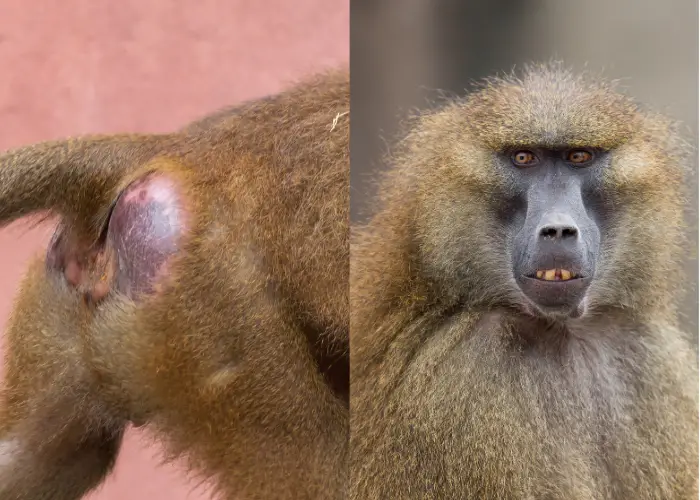
A. Description and Physical Characteristics
Guinea baboons(Papio papio) are medium-sized primates with a reddish-pink patch on their buttocks. Males are larger than females, weighing 20-30 kg (44-66 lbs), while females weigh around 10-15 kg (22-33 lbs).
They have a stocky build and a dog-like muzzle, similar to other baboon species. Their fur is dark brown to light brownish-grey, with a lighter color on the underside. They have a long, non-prehensile tail that ends with a small tuft.
B. Habitat and Distribution
This monkey with red butt species is native to West Africa and can be found in Guinea, Senegal, Gambia, Mali, and Mauritania.
Their habitats include dry forests, savannahs, and gallery forests along rivers. They are adaptable and can also be found in agricultural areas, where they may conflict with humans due to crop raiding.
C. Social Behavior and Reproduction
Guinea baboons live in multi-male, multi-female groups called troops, consisting of up to 200 individuals. They have a flexible and less hierarchical social structure than other baboon species.
Males form strong alliances with other males, which is important for maintaining their position within the group and gaining access to females.
Mating occurs throughout the year but is more frequent during increased food availability. The gestation period is approximately six months, and females usually give birth to a single offspring.
Both males and females play a role in caring for the young, with other troop members also providing support.
D. Conservation Status
The IUCN Red List classifies the Guinea baboon as Near Threatened. Their populations have declined in recent years due to habitat loss from deforestation and agricultural expansion, hunting for bushmeat, and human-wildlife conflict.
Conservation efforts include monitoring populations, creating and managing protected areas, and implementing educational programs to raise awareness about the importance of Guinea baboons and their habitats.
3. Japanese Macaque

A. Description and Physical Characteristics
Japanese macaques(Macaca fuscata), also known as snow monkeys, are medium-sized primates with a reddish-pink patch on their buttocks. Males are larger than females, with males weighing between 11-14 kg (24-31 lbs) and females weighing 8-10 kg (18-22 lbs).
They have a stocky build and a short, stubby tail. Their fur is dense and brownish-grey, providing insulation against the cold. During winter, their faces may turn red due to increased blood flow, which helps them maintain body heat in freezing temperatures.
B. Habitat and Distribution
Japanese macaques are found throughout most of the Japanese archipelago, from subtropical lowlands to subalpine forests.
They inhabit a variety of forest types, including evergreen, deciduous, and mixed forests. They are the world’s most northerly-dwelling non-human primates, capable of surviving extreme cold and snow.
C. Social Behavior and Reproduction
Japanese macaques live in multi-male, multi-female troops, ranging in size from a few dozen to several hundred individuals. They have a hierarchical social structure, with dominant males and females occupying the top positions.
Grooming is an essential social behavior, helping to reinforce bonds within the group and maintain group cohesion.
Mating season for Japanese macaques typically occurs from October to December. The gestation period is about six months, and females usually give birth to a single offspring.
Mothers provide the majority of care for their young, but other females in the troop may also assist in nurturing and protecting the infants.
D. Conservation Status
The IUCN Red List classifies the Japanese Macaque as Least Concern. While their population is stable, they face localized threats such as habitat loss, human-wildlife conflict, and hunting.
Conservation efforts include habitat preservation, population monitoring, and educational programs to raise awareness about the importance of Japanese macaques and their habitats.
In some areas, they are also protected by law, and efforts are made to mitigate conflicts between macaques and humans.
4. Rhesus Macaque
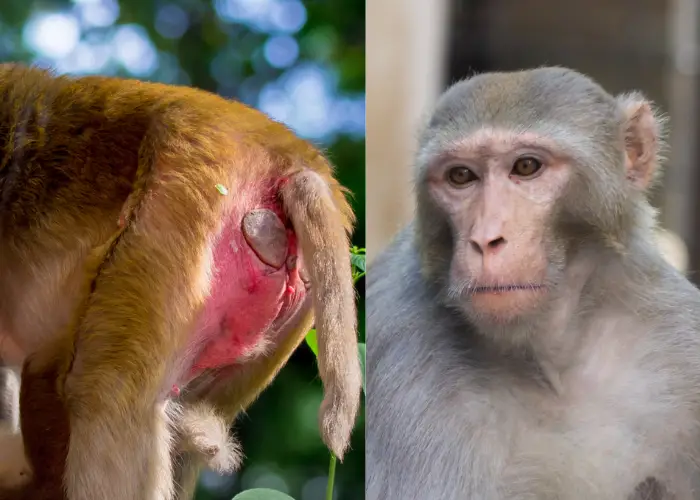
A. Description and Physical Characteristics
Rhesus macaques(Macaca mulatta) are medium-sized primates with a reddish-pink patch on their buttocks. Males are larger than females, with males weighing between 7-12 kg (15-26 lbs) and females weighing 5-8 kg (11-18 lbs).
They have a stocky build, a short tail, and a dog-like muzzle. Their fur is generally light brown or greyish-brown, with a lighter underside.
B. Habitat and Distribution
Rhesus macaques are widely distributed across South, Central, and Southeast Asia. Their range includes countries such as India, Nepal, Bangladesh, Pakistan, Bhutan, China, and Myanmar.
They inhabit various habitats, including grasslands, forests, and urban areas. Rhesus macaques are highly adaptable and thrive in various environments, from mountainous regions to human-dominated landscapes.
C. Social Behavior and Reproduction
Rhesus macaques live in multi-male, multi-female groups called troops, which can vary in size from a few individuals to several hundred.
They have a hierarchical social structure, with dominant males and females occupying the top positions. Grooming is an essential social behavior, helping to reinforce bonds within the group and maintain group cohesion.
Mating season for rhesus macaques typically occurs from October to January. The gestation period is about 5.5 months, and female rhesus macaques usually give birth to a single offspring.
Mothers provide the majority of care for their young, but other females in the troop may also assist in nurturing and protecting the infants.
D. Conservation Status
The IUCN Red List classifies the rhesus macaque as Least Concern. While their population is stable and not currently facing significant threats, localized populations may be vulnerable to habitat loss, human-wildlife conflict, and hunting.
Conservation efforts include habitat preservation, population monitoring, and educational programs to raise awareness about the importance of rhesus macaques and their habitats. In some areas, they are also protected by law, and efforts are made to mitigate conflicts between macaques and humans.
5. Stump-tailed Macaque
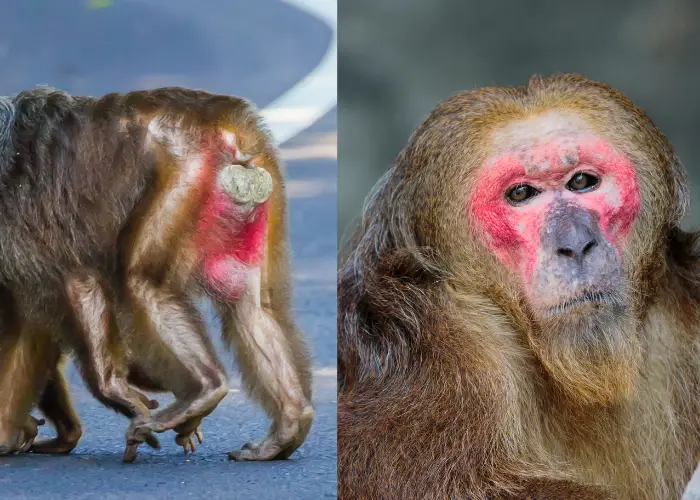
A. Description and Physical Characteristics
Stump-tailed macaques(Macaca arctoides) are medium-sized primates with distinctive reddish-pink patches on their buttocks.
They have a stocky build and a short, stump-like tail, which gives them their name. Males are larger than females, with males weighing 9-18 kg (20-40 lbs) and females weighing 7-12 kg (15-26 lbs). Their fur is dense and brown or reddish-brown, with a lighter underside.
B. Habitat and Distribution
Stump-tailed macaques are found in South and Southeast Asia, including countries such as India, Nepal, Bhutan, Bangladesh, Myanmar, Thailand, Laos, Vietnam, and China.
They inhabit various habitats, including evergreen, deciduous, mixed forests, bamboo, and pine forests.
C. Social Behavior and Reproduction
Stump-tailed macaques live in multi-male, multi-female groups, ranging in size from 20 to 60 individuals. They have a hierarchical social structure, with dominant males and females occupying the top positions.
Grooming is an essential social behavior that helps maintain group cohesion and reinforce bonds between individuals.
Mating season for stump-tailed macaques typically occurs from November to January. The gestation period is about six months, and females usually give birth to a single offspring.
Mothers provide the majority of care for their young, but other females in the troop may also assist in nurturing and protecting the infants.
D. Conservation Status
The IUCN Red List classifies the stump-tailed Macaque as Vulnerable. Their populations have declined due to habitat loss from deforestation, agricultural expansion, bushmeat hunting, and the illegal pet trade.
Conservation efforts include habitat preservation, population monitoring, and educational programs to raise awareness about the importance of stump-tailed macaques and their habitats.
6. Celebes Crested Macaque
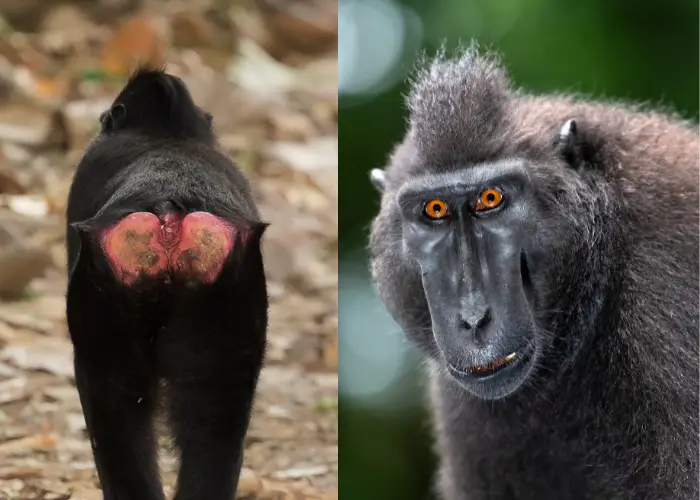
A. Description and Physical Characteristics
Celebes crested (Macaca nigra) macaques are medium-sized primates with a reddish-pink patch on their buttocks. They have a distinctive crest of long hair on the top of their head, which gives them their name.
Males are larger than females, with males weighing 8-10 kg (18-22 lbs) and females weighing 5-7 kg (11-15 lbs). Their fur is black or dark brown, with a lighter underside.
B. Habitat and Distribution
Celebes crested macaques are found only on the Indonesian island of Sulawesi, primarily in the northeastern part of the island. They inhabit primary and secondary forests, mangroves, and coastal areas.
C. Social Behavior and Reproduction
Celebes crested macaques live in multi-male, multi-female groups, ranging in size from 5 to 25 individuals. They have a hierarchical social structure, with dominant males and females occupying the top positions.
Grooming is an essential social behavior that helps maintain group cohesion and reinforce bonds between individuals.
Mating season for Celebes crested macaques typically occurs from June to August. During this time, Female Celebes crested macaque’s rear end swell enormously.
The gestation period is about 5.5 months, and females usually give birth to a single offspring. Mothers provide the majority of care for their young, but other females in the troop may also assist in nurturing and protecting the infants.
D. Conservation Status
The IUCN Red List classifies the Celebes crested macaque as Critically Endangered. Their populations have declined significantly due to habitat loss from deforestation, agricultural expansion, human encroachment, hunting for bushmeat, and the illegal pet trade.
Conservation efforts include habitat preservation, population monitoring, and educational programs to raise awareness about the importance of Celebes crested macaques and their habitats.
7. Mandrills

A. Description and Physical Characteristics
Mandrills(Mandrillus sphinx) are large, colorful primates closely related to baboons. They are known for their striking facial coloration, which includes blue and red skin on their muzzles and a yellow beard.
Males are significantly larger than females, weighing 19-37 kg (42-82 lbs), while females weigh 10-15 kg (22-33 lbs). Male mandrills also have a prominent reddish-pink patch on their buttocks, which plays a role in their social interactions and reproductive behaviors.
B. Habitat and Distribution
Mandrills are found in the tropical rainforests of western and central Africa, primarily in Cameroon, Gabon, Equatorial Guinea, and the Republic of the Congo. They prefer dense forests with plenty of cover and access to water sources.
C. Social Behavior and Reproduction
Mandrills live in large, multi-male, multi-female groups called hordes or troops, consisting of up to several hundred individuals. Within these groups is a strict hierarchy, with a dominant male, the alpha male, at the top.
The alpha male’s buttocks are often the most vibrant in color, indicating his dominance within the group.
Mandrills communicate through vocalizations, body language, and facial expressions. Grooming is essential to social interactions, reinforcing individual bonds and maintaining group harmony.
Reproduction in mandrills is seasonal, with females giving birth during the wet season. Males with more vibrant buttocks are more likely to attract mates.
The gestation period is about six months, and females typically give birth to a single infant. The mother primarily provides parental care, although other group members may assist in caring for the young.
D. Conservation Status
The IUCN Red List classifies the mandrill as Vulnerable. Their populations have declined due to habitat loss, hunting for bushmeat, and the pet trade.
Conservation efforts for mandrills include habitat preservation, anti-poaching measures, and educational programs to raise awareness about the importance of mandrills and their habitats. In some areas, the law also protects mandrills, and efforts are made to mitigate conflicts between mandrills and humans.
“Red Butt” in Monkey Significance

A. Role in Social Interactions
The reddish or reddish-pink coloration on the buttocks of certain monkey and primate species plays a significant role in their social interactions.
This distinctive coloration makes it easier for individuals to communicate their emotions and intentions to other group members. In some species, the color intensity of the buttocks may indicate an individual’s social status or rank within the group.
A more vibrant color may signal a higher social rank, asserting dominance and helping to maintain the group’s hierarchical structure.
B. Role in Mating Behavior
In addition to its role in social interactions, the reddish or reddish-pink coloration on the buttocks of certain primates also plays a crucial role in their mating behavior.
This conspicuous coloration serves as a signal to potential mates, with more vibrant colors often being perceived as more attractive. During the mating season, the color intensity may increase, emphasizing its significance in attracting a mate.
The vibrant coloration on the buttocks may also indicate an individual’s health or genetic fitness, suggesting that the individual would be a suitable mate for producing healthy offspring.
Conservation Efforts

A. Threats Faced by These Species
Many monkey and primate species with reddish or reddish-pink buttocks face various threats that jeopardize their survival. Some of these threats include:
- Habitat loss and fragmentation: Deforestation, agricultural expansion, and urbanization contribute to the destruction and fragmentation of their natural habitats, leading to reduced access to food, shelter, and mates.
- Human-wildlife conflict: As human populations grow and encroach on primate habitats, conflicts between primates and humans may arise. Primates may raid crops or enter human settlements, leading to human retaliation.
- Hunting and poaching: Some of these species are hunted for bushmeat or captured for the illegal pet trade, contributing to the decline of their populations.
- Disease: Infectious diseases, exacerbated by habitat fragmentation and increased contact with humans, can pose significant risks to primate populations.
B. Initiatives to Protect their Habitats and Populations
Various initiatives have been implemented to protect the habitats and populations of these primates, including:
- Creation and enforcement of protected areas: Establishing and effectively managing protected areas can help conserve primate habitats and ensure the long-term survival of their populations.
- Reforestation projects: Reforestation efforts can help restore degraded habitats and improve connectivity between fragmented primate populations.
- Community-based conservation: Involving local communities in conservation efforts can provide economic incentives and empower them to protect primate habitats and populations.
- Education and awareness campaigns: Raising public awareness about the importance of these species and their habitats can help garner support for conservation initiatives and reduce human-wildlife conflict.
C. Importance of Preserving these Species
Preserving primate species with reddish or reddish-pink buttocks is essential for several reasons:
- Ecological importance: These primates often play crucial roles in their ecosystems, such as seed dispersal, pollination, and maintaining forest health.
- Scientific value: Studying these species can improve our understanding of primate behavior, social structures, and communication, as well as shed light on the evolutionary links between primates, including our species.
- Cultural significance: Many of these primates hold cultural importance for local communities, featuring in folklore, mythology, and religious beliefs.
- Biodiversity: Preserving these species contributes to overall biodiversity, which is essential for maintaining the health and resilience of ecosystems.
Conclusion
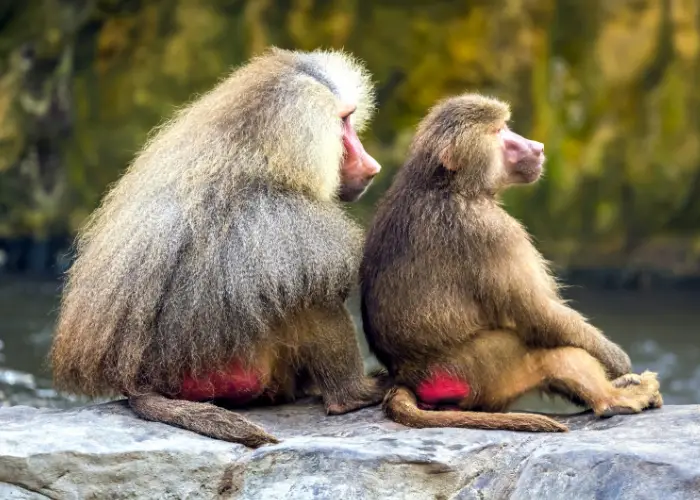
Several primate species exhibit red or reddish-pink buttocks, including Hamadryas baboons, Guinea baboons, Japanese macaques, Rhesus macaques, Stump-tailed Macaque, Celebes Crested Macaque, and Mandrills.
This distinct coloration is crucial in social interactions, communication, and mating behavior.
These primates face various threats, including habitat loss, human-wildlife conflict, and hunting. Conservation efforts are underway to protect their habitats and populations, ensuring long-term survival.
These primates are essential for maintaining ecosystem health through seed dispersal, pollination, and forest maintenance.
Studying them offers valuable insights into primate behavior, social structures, communication, and the evolutionary links between primates, including humans. Preserving these species also upholds their cultural significance and contributes to overall biodiversity.
CHECK OUT OTHER MONKEY SPECIES BELOW:
Frequently Asked Questions
Why are Baboons’ buttocks blue?
Male baboons have blue buttocks due to the combination of a thin epidermis and the presence of specialized dermal cells called “iridophores,” which reflect blue light, enhancing their visual signaling.
Do Male Baboons Have Red Bottoms?
Male baboons have red bottoms, although their redness can vary depending on age, social status, and sexual activity. The coloration serves as a visual signal in social and mating contexts.
REFERENCES:
1. Hamadryas baboon. (2023, April 2). In Wikipedia. https://en.wikipedia.org/wiki/Hamadryas_baboon
2. Guinea baboon. (2023, April 2). In Wikipedia. https://en.wikipedia.org/wiki/Guinea_baboon
3. Japanese macaque. (2023, March 6). In Wikipedia. https://en.wikipedia.org/wiki/Japanese_macaque
4. Rhesus macaque. (2023, March 13). In Wikipedia. https://en.wikipedia.org/wiki/Rhesus_macaque
5. Stump-tailed macaque. (2023, February 3). In Wikipedia. https://en.wikipedia.org/wiki/Stump-tailed_macaque
6. Celebes crested macaque. (2022, November 11). In Wikipedia. https://en.wikipedia.org/wiki/Celebes_crested_macaque
7. Mandrill. (2023, April 17). In Wikipedia. https://en.wikipedia.org/wiki/Mandrill
8. The IUCN Red List of Threatened Species. IUCN Red List of Threatened Species. (n.d.). Retrieved April 25, 2023, from https://www.iucnredlist.org/

